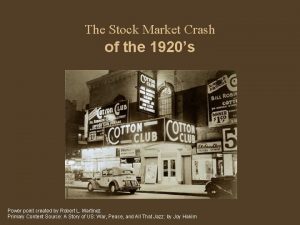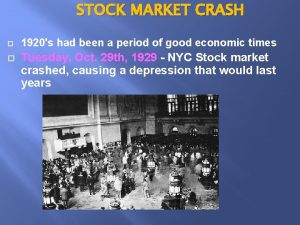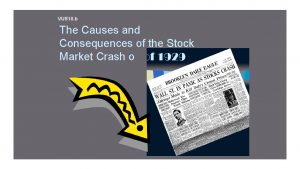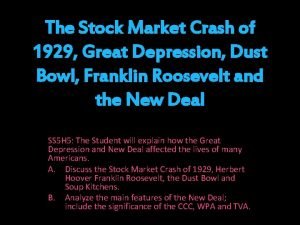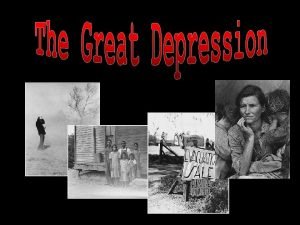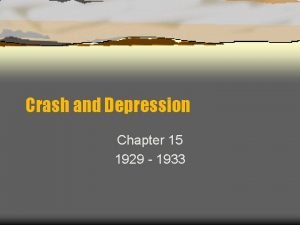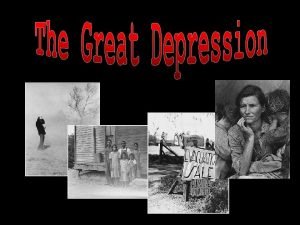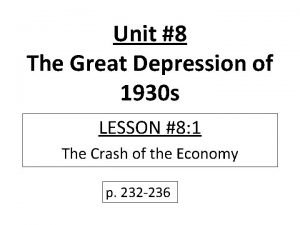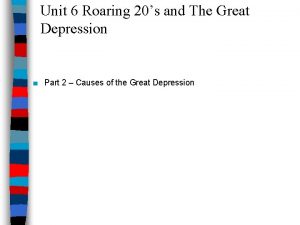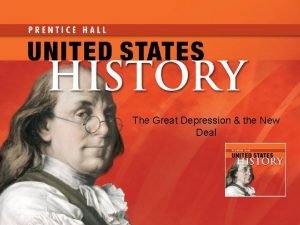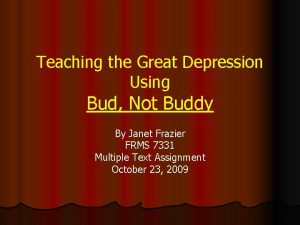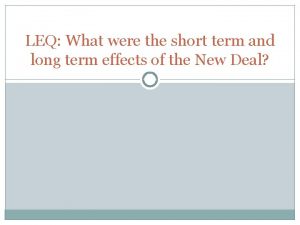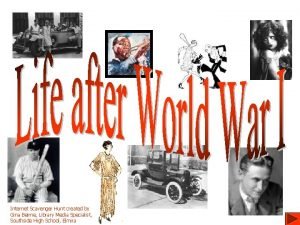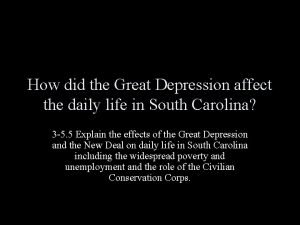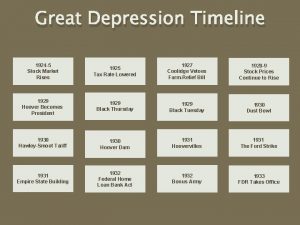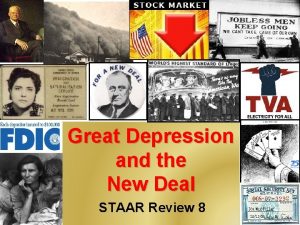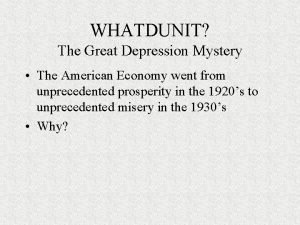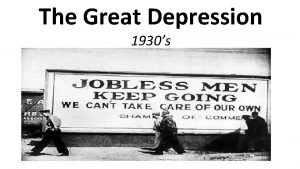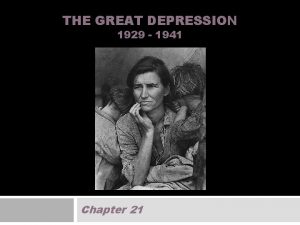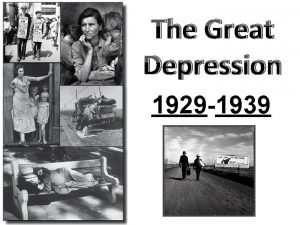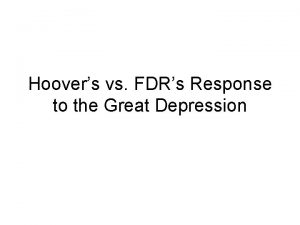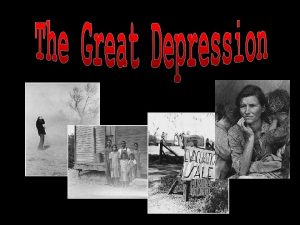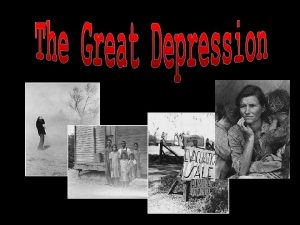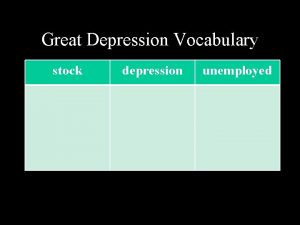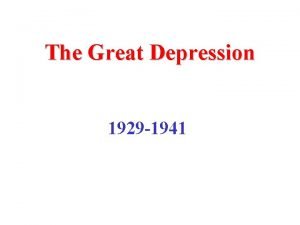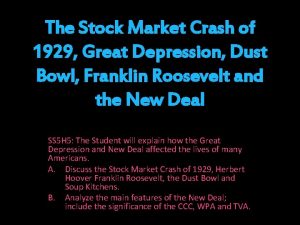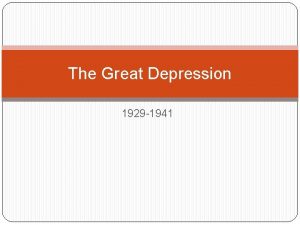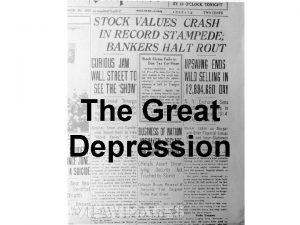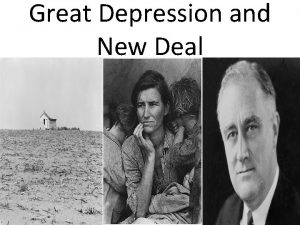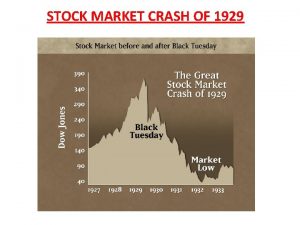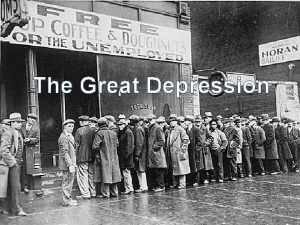THE GREAT DEPRESSION Stock Market Crash Rising stock














































- Slides: 46

THE GREAT DEPRESSION

Stock Market Crash Rising stock market symbol of prosperity during 1920 s “conspicuous prosperity” Paper wealth (credit) masked rot in American Economy Before crash: September 3, 1919 the Dow Jones Industrial Average of major stocks reached an all-time high of 381 Stock prices plunged Next day, bankers bought millions in stocks to stabilize prices Led by J. P. Morgan Jr. Stocks steadily increased from March 1928 to September 1929 October 24, 1929 Unprecedented volume of selling 13 million shares Unemployment already high due to mechanization in factories Housing starts feel in 1927 Internationally production up and demand down Black Thursday Black Tuesday October 29, 1929 Bottom fell out Investors wanted to sell stock 16 million shares By November average down to 198, in three years hit all time low of 41 Wealth “vanished”

America survived through other depressions b/c people lived on farms and could provide for themselves This depression different since America was now urbanized

Causes of the Crash Uneven distribution of income Wages rose little compared to productivity and corporate profits Stock market speculation Get rich by “playing” market mentality Buying on the margin Excessive use of credit Belief that boom would last Overproduction of goods Weak farm economy Prosperity of 20 s never reached farmers Government policies Little business regulation High tariffs Hurt US farmers and trade Global economic policies War reparations crushing Europe’s economy


Effects of the Crash GNP Nation’s income Dropped from $104 billion to $56 billion in four years Declined over 50% Banks 20% closed Not that uncommon Rural banks with low funds the problem 10 million savings accounts wiped out Unemployment 1933 = 13 million people 25% of the workforce


Hoover’s Response Thought prosperity would return Urged Americans to exercise voluntary action and restraint “best education in the world for wandering men, women, and children traveling around the world” Urged businesses not to cut wages, unions not to strike, etc. Didn’t ask Congress for legislative action until summer of 1930 Believed in self-reliance 1931 - called for tax increase Feared budget deficit

Too little, Too late Hawley-Smoot Tariff 1930 Schedule of tariff rates Highest in history 31 to 49% on foreign imports Thought it would protect U. S. business Europe responded Trade declined for ALL Created 1929, powers expanded 1931 Authorized to help stabilize prices To modest to handle massive overproduction Debt Moratorium Federal Farm Board Reconstruction Finance Corporation (RFC) Created early 1932 (election year) Went against Hoover’s conservative beliefs No more payment of Dawes plan Measure to prop up faltering railroads, life insurance companies, etc. Gave emergency loans to major economic institutions $1. 2 billion

Despair and Protest Suicide rate 30% in 1932 Unrest on farms Farmers banded together to stop banks from foreclosing farms Farm Holiday Association Bonus march Summer 1932 One of the worst years of depression 1, 000 unemployed WWI vets marched to Washington to demand payment of bonuses Bonuses scheduled to be paid in 1945 Joined by thousands more Violent clash Mac. Arthur called in to “disperse” crowd 1, 000 troops Eisenhower, Patton there Negative pubic reaction More than 100 casualties 2 babies



Election of 1932 Depression’s worst year Republicans Re-nominated Hoover Promised to repeal prohibition, keep tariff high, balance budget Warned Dem. victory would worsen depression Democrats Nominated NY governor Franklin D. Roosevelt Barely, lots of criticism Exuded confidence Pledged a “new deal” Repeal Prohibition Aid for unemployed Public works, aid to farmers Cuts in government spending

Results Only real issue to voters the depression 60% choose Roosevelt ticket Congress won large democrat majority in both houses Hoover a “lame-duck” 20 th amendment passed to shorten time between election and inauguration

F. D. R. and the “New Deal” The Man Only child Philosophy Wealthy background Suffered from Polio as an adult Couldn't walk unaided Strengths Warm personality Gifted speaker Ability to inspire people Eleanor Relief: for people out of work Recovery: for business and economy Reform: of U. S. economic institutions Experienced politician NY legislator U. S. assistant to Navy 1920 Dem. Nominee for Vice President Most active first lady in history Social conscience Wrote newspaper column Three R’s The Brain Trust Group of advisors from NY Louis Howe Chief political advisor Professors Rexford Tugwell Raymond Moley Adolph A. Berle Jr. Appointments Most diverse in U. S. history African-Americans, Catholics, Jews, and women Frances Perkins 1 st female cabinet member Secretary of labor

“Alphabet Soup”

The 1 st 100 days Sworn in March 4, 1933 Called congress into a special 100 -day long session Beer-Wine Revenue Act Repealed 18 th amend. Laws Bank Holiday 1 st act of business Banks closed March 6 Nationwide, holiday 1 st fireside chat Banks would reopen after governments reorganized Emergency Banking Act Permitted healthy banks to reopen Procedures for failed banks Fireside chats Started March 12, 1933 Reassured Americans Explained legislation March 9 - June 16 Congress passed every law Repeal of Prohibition Financial recovery Emergency Banking relief Act Federal Deposit Insurance Corporation Designed to protect savings up to $5, 000 Home Owners Loan Corporation Refinanced loans, prevented foreclosures Farm credit Administration Loans to farmers

100 days continued Relief for the unemployed Federal Emergency Relief Administration Industrial recovery 1 st welfare program Grants of federal money to states and local governments for soup kitchens, other relief 1 st National Recovery Act Government control of production, labor and costs NRA would enforce it Attempt to guarantee reasonable profits for business and fair wages and hours for labor Gave workers right to organize Used by Frances Perkins to ban child labor $500 million to state and local agencies Public Works Administration Money to build roads, bridges, dams, other pubic works Civilian Conservation Corps Employed young men on projects on federal lands (18 - 25) Worked relief with environmental programs By 1935 - 500, 000 employed Tennessee Valley Authority Hydroelectric power program National Recovery Administration 1933 Farm production control Agricultural Adjustment Administration Encouraged to reduce production, raise farm prices Paying farmers not to plant


Other New Deal Programs Civil Works Administration Created jobs Hired laborers for temporary construction projects for government FDR worried about creating a permanent underclass dependent on welfare Securities and Exchange Commission 1934 Created to regulate the stock market and to place limits on speculative practices that led to crash in “ 29 Placed Joe Kennedy in charge Would know all the tricks Federal Housing Administration Gave construction industry and homeowners a boost by insuring bank loans for building new houses and repairing old ones Off the Gold Standard Looked at in an effort to halt deflation (falling prices)

Failures and Controversies NRA Lots of violations, complaints 1935 Supreme court declared unconstitutional in Schechter v. U. S. Regulatory powers belonged to Congress not President NRA regulated commerce within states AAA Did not help farm laborers/ migrant workers Found unconstitutional in 1936 Illegal use of the governments power to tax

Second Hundred Days 1935 Democrats re-elected to congress in 1934 Picked up slack of AAA provided loans to sharecroppers, tenants and small farmers established migrant worker camps Increased congressional majorities New legislation focused on relief and reforms guaranteed right to join union Works Progress Administration Spent billions to provide jobs Work not handouts 1 st year employed 3. 4 million Rural Electrification Administration loans to electric cooperatives Total over 8 million Construction, writing, art Offered youth money to stay in school Reforms National Labor Relations (Wagner) Act 1935 replaced NRA Relief Resettlement Administration 1935 Federal taxes Revenue Act 1935 increased taxes of wealthy few

Social Security Act 1935 Most important of all new deal laws Drafted by Frances Perkins Created federal insurance program based on automatic collection of taxes from employees and employers throughout working career Caused brief recession in 1937 Trust fund would pay monthly payments to retired over age 65 Establishe the principle of federal responsibility for social welfare Laid foundation Also receiving benefits under law: Unemployed Disabled Dependent children and mothers


Election of 1936 Economy had improved but still weak and unstable Democrats Re-nominated F. D. R. Enormously popular among workers and small farmers “one issue, its myself, and the people must either be for me or against me” Republicans Nominated Alf London Supported by Business Part of American Liberty League Group of business leaders that opposed F. D. R. Fiscal conservative Results Landslide victory for F. D. R. Greatest asset ability to restore confidence New coalition of democratic voters African-Americans VERY important!!



Opponents of the New Deal Liberal Critics Socialists, extreme liberals Demagogues Clifford Odet -Waiting for Lefty 1935 Weekly radio broadcasts Said N. D. did too much for business and too little for unemployed and working poor Wanted to nationalize banks Called F. D. R. the “great betrayer” and a liar From Detroit Thought government had too much power Relief programs bordered on Socialist American Liberty League Al Smith Dr. Francis Townsend Hero to senior citizens Proposed 2 % federal sales tax to pay retired $200 a month Conservative Critics Father Charles Coughlin Required to spend $ within 30 days Huey Long “Kingfish” Gov. from Louisiana “Share our wealth” 100% income tax over 1 million dollars Everyman would be a King Ran for Presidential nom. Attempted assassination


The Supreme Court Most difficult challenge in F. D. R. ’s first term Reaction Called “court-packing” bill Both Republicans and Democrats upset 1 st major congressional defeat Killed NRA and AAA Plus 9 other measures All conservative judges Opened floodgates Court-Reorganization Thought re-election meant he could solve court problem Proposed bill 1937 President be allowed to appoint additional justice for each justice over age 70. 5 Aftermath Negative reaction Court already changing views before bill 1937 upheld Wagner Act and Social Security Act



Rise of Unions National Industrial Recovery Act 1933 and Wagner Act 1935 Automobiles GM Plant Michigan 1937 Legalized unions Membership increased Sit-down strike, organized by CIO Strike successful United Auto Workers union organized Not so lucky at Ford plant Formation of C. I. O. Steel 1936 Memorial day 1937 Chicago Committee of Industrial Organizations 1935 Leader John L. Lewis Broke off from A. F. L. Welcomed all workers in a particular industry regardless of gender, skill, or race Strikes Republic Steel Company Fair Labor Standards Act Minimum wage, max workweek of 40 hrs, childlabor restrictions

Last Phase of the New Deal New deal slowed down Weakened New Deal Recession 1937 -1938 Causes Government policy Social Security reduced consumer spending Withdrew $2 billion from circulation Keynesian Economics Mistake trying to balance budget Deficit spending needed to initiate economic growth Worked- late 1938 Unemployment declined, industrial output increased Economy improved but: Court-packing left distrust with congress and people New coalition formed to block new deal legislation Fears of Nazi Germany


Life during the Depression Women Added pressures More women sought work African Americans Unemployment rate higher Often excluded from relief programs More government positions Still paid less than men Severe drought early 1930 s Region became a dust bowl “Black rollers” Nine teenage boys accused of rape in Alabama Framed, all-white jury Called “penny auctions” Thousands of “Okies” migrated to California John Steinbeck’s “The Grapes of Wrath” Also called “exodusters” or “Arkies” Improvements WPA, CCC = jobs Government positions Called “dirty thirties” Neighbors came together to try and save each others farms Racial tensions in South Anti-lynching bill defeated Scottsboro 8 Dust Bowl Farmers Discrimination continued Fair Employment Practices Committee Executive order 1941 F. D. R. appointed African-Americans to government positions




Life during Depression Native Americans Granted citizenship and voting rights in 1924 Indian Reorganization Act 1934 Repealed Dawes Act of 1887 Returned lands to control of tribes and supported preservation of native culture Enabled natives to buy back land John Collier Commissioner of Bureau of Indian Affairs 1933 Improved life on reservations Conservation and CCC projects to employ natives Mexican Americans Two million in U. S. Suffered from discrimination Principal source of labor in 1920 s During depression high unemployment and drought caused dramatic growth in white migrant workers Thousands returned to Mexico 500, 000 Voluntary and forced

How did people get through it?


Popular Actors Shirley Temple Clark Gable Carol Lombard Mae West Comedians Jack Benny George Burns

Literature Grapes of Wrath- Steinbeck Music Gershwin- “Porgy and Bess” Swing dancing, music


Looking Ahead What ended the depression? FDR’s 1 st term Annual growth up 9% Unemployment down from between 25 -33% TO 9 -14% 2 nd term Unemployment up again Would not go down until after 1941
 Stock market cartoons
Stock market cartoons Black tuesday political cartoon
Black tuesday political cartoon Stock market crash in 1929
Stock market crash in 1929 Stock market crash
Stock market crash Black friday stock market crash
Black friday stock market crash Fun facts about the stock market crash of 1929
Fun facts about the stock market crash of 1929 Vus.10b when was the stock market crash?
Vus.10b when was the stock market crash? Stock market crash def
Stock market crash def New deal tennessee valley authority
New deal tennessee valley authority 550wgr
550wgr Stock market crash
Stock market crash Chapter 15 crash and depression
Chapter 15 crash and depression Leader challenger
Leader challenger Marketing segmentation targeting positioning
Marketing segmentation targeting positioning 1939 market crash
1939 market crash Tennessee valley authority new deal
Tennessee valley authority new deal Rarig great depression
Rarig great depression Great depression
Great depression The ingenious quarterback
The ingenious quarterback Foreclosure great depression
Foreclosure great depression Five effects of the great depression
Five effects of the great depression Five effects of the great depression
Five effects of the great depression How did the great depression impact the world
How did the great depression impact the world What is the dawes plan
What is the dawes plan Bud not buddy
Bud not buddy Donald justice pantoum of the great depression
Donald justice pantoum of the great depression The great depression summary
The great depression summary What is deflation
What is deflation Okies great depression
Okies great depression The great depression leq
The great depression leq Five effects of the great depression
Five effects of the great depression How did the great depression affect daily life
How did the great depression affect daily life Timeline of the great depression
Timeline of the great depression Great depression causes
Great depression causes Mexican repatriation apush
Mexican repatriation apush Boxing during the great depression
Boxing during the great depression Birth rate during the great depression
Birth rate during the great depression Overspeculation great depression
Overspeculation great depression Great depression vocab
Great depression vocab Great depression vocabulary words
Great depression vocabulary words Great depression bank runs
Great depression bank runs Http://www.history.com/topics/great-depression
Http://www.history.com/topics/great-depression Great depression
Great depression Hawley-smoot tariff great depression
Hawley-smoot tariff great depression Hardship and suffering during the depression
Hardship and suffering during the depression Lesson 3 effects of the great depression
Lesson 3 effects of the great depression Hoover v. fdr responses to the great depression
Hoover v. fdr responses to the great depression



